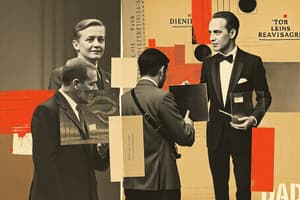Podcast
Questions and Answers
What is an artefact in drama?
What is an artefact in drama?
- A character's backstory
- A type of role play
- An object used to signify context, actions, and meaning (correct)
- A form of improvisation
What does backstory provide to a character?
What does backstory provide to a character?
A history to a character or plot in the play
Define cross-cutting in drama.
Define cross-cutting in drama.
Changing back and forth between scenes or episodes of action
What is freeze frame?
What is freeze frame?
What is the purpose of hot seating?
What is the purpose of hot seating?
What is improvisation in drama?
What is improvisation in drama?
What is role play?
What is role play?
What occurs during role reversal in a scene?
What occurs during role reversal in a scene?
What is role on the wall?
What is role on the wall?
What is still image in drama?
What is still image in drama?
What is a stimulus in drama?
What is a stimulus in drama?
What does storyboarding entail?
What does storyboarding entail?
What is tableau in drama?
What is tableau in drama?
What is teacher in role?
What is teacher in role?
What types of things does technique refer to in drama?
What types of things does technique refer to in drama?
What is thought tracking?
What is thought tracking?
Flashcards are hidden until you start studying
Study Notes
Drama Key Terms
-
Artefact: Object that serves as a starting point for drama activities; signifies context, actions, and meaning when used as stage props.
-
Back Story: Historical context provided for a character or plot, enhancing depth prior to the drama's unfolding.
-
Cross-Cutting: Technique involving alternating scenes or episodes, where action freezes in one scene before shifting to another, creating a dynamic narrative flow.
-
Freeze Frame: Technique to pause action, allowing characters to step out and reveal thoughts or emotions to the audience while the rest of the scene freezes.
-
Hot Seating: Deep character exploration method where an actor responds in character to questions, enhancing understanding of motivations and emotions.
-
Improvisation: Spontaneous performance without pre-planned dialogue or action; includes structures agreed upon in advance for guided creativity.
-
Role Play: Engaging in a specific, defined role (e.g., doctor or teacher) without aimed psychological analysis; not intended for public performance.
-
Role Reversal/Transfer: Actors swap roles during rehearsal or improvisation to gain perspective and better insights into their characters.
-
Role on the Wall: Life-size outline representation of a character where group members annotate physical traits and personal details, facilitating character development.
-
Still Image: Creation of a frozen moment visually summarizing a scene; useful for exploring character positioning, non-verbal communication, and ensemble dynamics.
-
Stimulus: Artefact employed as a creative starting point for devising original drama and performances.
-
Storyboarding: Visual representation of a play’s sequence through images and text, detailing planned action.
-
Tableau(x): Dramatic grouping of characters; can be dynamic with gestures and dialogue or a still image; crucial for stage pictures in dramatic representation.
-
Teacher in Role: A technique where a teacher engages in a role within the drama, prompting student reaction and response; role immersion for enhanced learning.
-
Technique: Refers to various forms, exercises, and strategies utilized in drama to explore meaning, encompassing the full range of physical and psychological actor training methods.
-
Thought Tracking: Exercise that vocalizes a character’s internal thoughts, often combined with freeze frames or still images to add depth to scenes.
Studying That Suits You
Use AI to generate personalized quizzes and flashcards to suit your learning preferences.




